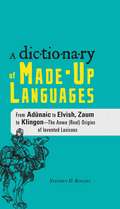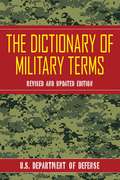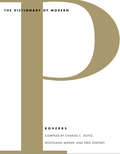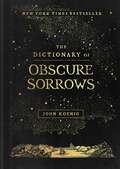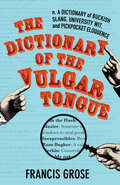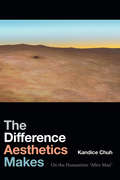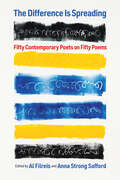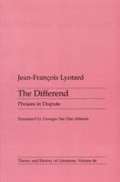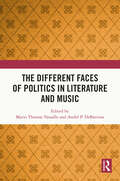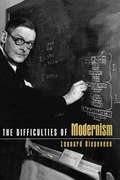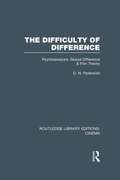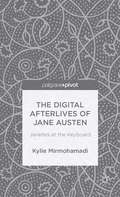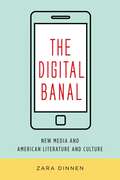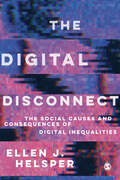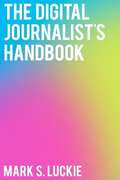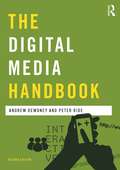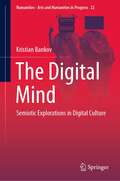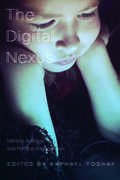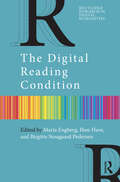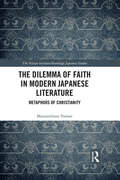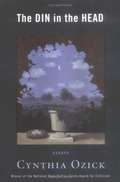- Table View
- List View
The Dictionary of Made-Up Languages: From Elvish to Klingon, The Anwa, Reella, Ealray, Yeht (Real) Origins of Invented Lexicons
by Stephen D RogersCan you converse in Klingon? Ask an Elf the time of day? Greet a speaker of Esperanto? These are among the more than 100 constructed languages you'll find in this book. For each one, author Stephen D. Rogers provides vocabulary, grammatical features, background information on the language and its inventor, and fascinating facts. What's more, easy-to-follow guidelines show you how to construct your own made-up language--everything from building vocabulary to making up a grammar.So pick up this dictionary! In no time, you'll be telling your friends, "Tsun oe nga-hu ni-Na'vi pangkxo a fì-'u oe-ru prrte' lu." ("It's a pleasure to be able to chat with you in Navi.")
The Dictionary of Military Terms
by DefenseThis is the comprehensive, standardized dictionary of military and associated terminology compiled and used by the Department of Defense. Divided into two sections, The Dictionary of Military Terms contains the terms and definitions approved for Department of Defense (DOD) and the North Atlantic Treaty Organization (NATO) use as well as a complete listing of commonly used abbreviations and acronyms. These military and associated terms, together with their definitions, constitute approved terminology for general use by all DOD components.The Dictionary of Military Terms supplements standard English-language dictionaries and standardizes military and associated terminology to improve communication and mutual understanding within the DOD, with other federal agencies, and among the United States and its allies. It is the primary terminology source when preparing correspondence, including policy, strategy, doctrine, and planning documents. This publication applies to the Office of the Secretary of Defense, the Services, the Joint Staff, combatant commands, DOD agencies, and all other DOD components, and covers terms such as:active defensebattle damage assessmentcandidate target listdirected energyevent matrixfootprinthub and spoke distributionmobilizationnonconventional assisted recoveryprotectionretained personnelspecial operationssurvival, evasion, resistance, and escapeweapons readiness stateand more!
The Dictionary of Modern Proverbs
by Wolfgang Mieder Fred R. Shapiro Charles Clay Doyle"You can't unring a bell. " "It takes a village to raise a child. " "Life is just a bowl of cherries. " We sometimes think of proverbs as expressions of ancient wisdom, but in fact new proverbs are constantly arising. This unique volume is devoted exclusively to English-language proverbs that originated in the twentieth and twenty-first centuries. The most complete and accurate such collection ever compiled,The Dictionary of Modern Proverbspresents more than 1,400 individual proverbs gathered and researched with the help of electronic full-text databases not previously used for such a project. Entries are organized alphabetically by key words, with information about the earliest datable appearance, origin, history, and meaning of each proverb. Mundane or sublime, serious or jocular, these memorable sayings represent virtually every aspect of the modern experience. Readers will find the book almost impossible to put down once opened; every page offers further proof of the immense vitality of proverbs and their colorful contributions to the oral traditions of today.
The Dictionary of Obscure Sorrows
by John KoenigA truly original book in every sense of the word, The Dictionary of Obscure Sorrows poetically defines emotions that we all feel but don&’t have the words to express, until now—from the creator of the popular online project of the same name.Have you ever wondered about the lives of each person you pass on the street, realizing that everyone is the main character in their own story, each living a life as vivid and complex as your own? That feeling has a name: &“sonder.&” Or maybe you&’ve watched a thunderstorm roll in and felt a primal hunger for disaster, hoping it would shake up your life. That&’s called &“lachesism.&” Or you were looking through old photos and felt a pang of nostalgia for a time you&’ve never actually experienced. That&’s &“anemoia.&” If you&’ve never heard of these terms before, that&’s because they didn&’t exist until John Koenig began his epic quest to fill the gaps in the language of emotion. Born as a website in 2009, The Dictionary of Obscure Sorrows has garnered widespread critical acclaim, inspired TED talks, album titles, cocktails, and even tattoos. The Dictionary of Obscure Sorrows &“creates beautiful new words that we need but do not yet have,&” says John Green, bestselling author of The Fault in Our Stars. By turns poignant, funny, and mind-bending, the definitions include whimsical etymologies drawn from languages around the world, interspersed with otherworldly collages and lyrical essays that explore forgotten corners of the human condition—from &“astrophe,&” the longing to explore beyond the planet Earth, to &“zenosyne,&” the sense that time keeps getting faster. The Dictionary of Obscure Sorrows is for anyone who enjoys a shift in perspective, pondering the ineffable feelings that make up our lives, which have far more in common than we think. With a gorgeous package and beautifully illustrated throughout, this is the perfect gift for creatives, word nerds, and people everywhere.
The Dictionary of the Vulgar Tongue: A Dictionary of Buckish Slang, University Wit, and Pickpocket Eloquence (Hesperus Classics)
by Francis GroseDo you know your abbess from your elbowshaker? Originally printed as a guide to street slang for men of quality, this reference guide will enrich your vocabulary with vulgar witticisms fashionable more than 200 years ago.The avowed purpose of this dictionary was to give men "of fashion" an insight into the inappropriate language of the street. Read in modern times it is by turn uproariously funny and deeply confusing and yet certain truths have remained—the need for the mot juste has not diminished. Many of the words should be brought back into common parlance forthwith: we have no term for the "admiral of the narrow seas," one who from drunkenness vomits into the lap of the person sitting opposite to him. We have perhaps less use for a word for "dobin rig" or "Stealing ribbons from haberdashers early in the morning or late at night; generally practised by women in the disguise of maid servants." Learn how the Georgians and early Victorians would insult each other and find out how some of today's words and derivations have come about in this quirky little volume.
The Didactic Muse: Scenes of Instruction in Contemporary American Poetry
by Willard SpiegelmanFrom Horace to Robert Frost ("a poem begins in delight and ends in wisdom") the major current of Western poetics has flowed from the wells of pleasure to the depths of instruction. That poetry serves pedagogy seemed as unarguable in the classical and early modern worlds as it may appear untenable in the contemporary one. Poets traditionally held their mirrors up to nature not simply to reflect it but to occasion reflection and right action in their readers.
The Difference Aesthetics Makes: On the Humanities “After Man”
by Kandice ChuhIn The Difference Aesthetics Makes cultural critic Kandice Chuh asks what the humanities might be and do if organized around what she calls “illiberal humanism” instead of around the Western European tradition of liberal humanism that undergirds the humanities in their received form. Recognizing that the liberal humanities contribute to the reproduction of the subjugation that accompanies liberalism's definition of the human, Chuh argues that instead of defending the humanities, as has been widely called for in recent years, we should radically remake them. Chuh proposes that the work of artists and writers like Lan Samantha Chang, Carrie Mae Weems, Langston Hughes, Leslie Marmon Silko, Allan deSouza, Monique Truong, and others brings to bear ways of being and knowing that delegitimize liberal humanism in favor of more robust, capacious, and worldly senses of the human and the humanities. Chuh presents the aesthetics of illiberal humanism as vital to the creation of sensibilities and worlds capable of making life and lives flourish.
The Difference Is Spreading: Fifty Contemporary Poets on Fifty Poems
by Al Filreis and Anna Strong SaffordSince its inception in 2012, the hugely successful online introduction to modern poetry known as ModPo has engaged some 415,000 readers, listeners, teachers, and poets with its focus on a modern and contemporary American tradition that runs from Walt Whitman and Emily Dickinson up to some of today's freshest and most experimental written and spoken verse. In The Difference Is Spreading, ModPo's Al Filreis and Anna Strong Safford have handed the microphone over to the poets themselves, by inviting fifty of them to select and comment upon a poem by another writer.The approaches taken are various, confirming that there are as many ways for a poet to write about someone else's poem as there are poet-poem matches in this volume. Yet a straight-through reading of the fifty poems anthologized here, along with the fifty responses to them, emphatically demonstrates the importance to poetry of community, of socioaesthetic networks and lines of connection, and of expressions of affection and honor due to one's innovative colleagues and predecessors. Through the curation of these selections, Filreis and Safford express their belief that the poems that are most challenging and most dynamic are those that are open—the writings, that is, that ask their readers to participate in making their meaning. Poetry happens when a reader and a poet come in contact with one another, when the reader, whether celebrated poet or novice, is invited to do interpretive work—for without that convergence, poetry is inert.
The Differend: Phrases in Dispute (Theory and History of Literature #46)
by Jean Francois LyotardReading Dossier; Title; Object; Thesis; Question; Problem; Stakes; Context; Pretext; Mode; Genre; Style; Reader; Author; Address.
The Different Faces of Politics in Literature and Music
by Mario Thomas Vassallo André P. DeBattistaThis book highlights the links between politics and governance and the arts. The essays in the volume show how literature and music have challenged those in power risking political censure. In addition, they also try to delineate how patronage has been used for propaganda, or to stir up national fervour. They focus on the tension and symbiosis between the politician and the artist foregrounding how they have always tried to influence, challenge, and, in some cases, undermine one another. This volume will serve as an indispensable source for researchers and academics in political science, the humanities and performing arts.
The Difficulties of Modernism
by Leonard DiepeveenFirst published in 2003. Routledge is an imprint of Taylor & Francis, an informa company.
The Difficulty of Difference: Psychoanalysis, Sexual Difference and Film Theory (Routledge Library Editions: Cinema)
by D. N. RodowickThis book argues that serious misreadings of Freud and Lacan on sexual difference have characterized prevailing models of psychoanalytic film criticism. In critiquing theories of identification and female spectatorship, the author maintains that early film theorists and feminist critics are equally guilty of imposing a binary conception of sexual difference on Freud’s thought. By embracing such a rigid definition of male/female difference, they fail to understand the fundamentally complex and fluid process of sexual identification as it is articulated in Freud’s writing, constructed in film texts, and negotiated by spectators. The book turns to Freud’s work on fantasy to develop an alternative model for interpreting sexuality in the visual and narrative arts, one that emphasizes a ‘politics of critical reading’ over accepted theories of ideological identification. Originally published in 1991, its strategic focus on psychoanalysis itself as an object of historical and critical inquiry, and not simply as a reading method is the unique quality of this book.
The Digital Afterlives of Jane Austen: Janeites at the Keyboard
by Kylie MirmohamadiThis is the first scholarly study to explore the ever-expanding world of online Austen fandom and fan fiction writing. Using case studies from the Internet writing community and publisher, Wattpad, as well as dedicated fan websites, it illuminates the literary processes and products that have given Austen multiple afterlives in the digital arena.
The Digital Banal: New Media and American Literature and Culture (Literature Now)
by Zara DinnenContemporary culture is haunted by its media. Yet in their ubiquity, digital media have become increasingly banal, making it harder for us to register their novelty or the scope of the social changes they have wrought. What do we learn about our media environment when we look closely at the ways novelists and filmmakers narrate and depict banal use of everyday technologies? How do we encounter our own media use in scenes of waiting for e-mail, watching eBay bids, programming as work, and worrying about numbers of social media likes, friends, and followers?Zara Dinnen analyzes a range of prominent contemporary novels, films, and artworks to contend that we live in the condition of the “digital banal,” not noticing the affective and political novelty of our relationship to digital media. Authors like Jennifer Egan, Dave Eggers, Sheila Heti, Jonathan Lethem, Gary Shteyngart, Colson Whitehead, Mark Amerika, Ellen Ullman, and Danica Novgorodoff and films such as The Social Network and Catfish critique and reveal the ways in which digital labor isolates the individual; how the work of programming has become an operation of power; and the continuation of the “Californian ideology,” which has folded the radical into the rote and the imaginary into the mundane. The works of these writers and artists, Dinnen argues, also offer ways of resisting the more troubling aspects of the effects of new technologies, as well as timely methods for seeing the digital banal as a politics of suppression. Bridging the gap between literary studies and media studies, The Digital Banal recovers the shrouded disturbances that can help us recognize and antagonize our media environment.
The Digital Disconnect: The Social Causes and Consequences of Digital Inequalities
by Ellen HelsperWith the increased digitisation of society comes an increased concern about who is left behind. From societal causes to the impact of everyday actions, The Digital Disconnect explores the relationship between digital and social inequalities, and the lived consequences of digitisation. Ellen Helsper goes beyond questions of digital divides and who is connected. She asks why and how social and digital inequalities are linked and shows the tangible outcomes of socio-digital inequalities in everyday lives. The book: Introduces the key theories and concepts needed to understand both ‘traditional’ and digital inequalities research. Investigates a range of socio-digital inequalities, from digital access and skills, to civic participation, social engagement, and everyday content creation and consumption. Brings research to life with a range of qualitative vignettes, drawing out the personal experiences that lay at the heart of global socio-digital inequalities. The Digital Disconnect is an expert exploration of contemporary theory, research and practice in socio-digital inequalities. It is also an urgent and impassioned call to broaden horizons, expand theoretical and methodological toolkits, and work collectively to help achieve a fairer digital future for all. Ellen J. Helsper is Professor of Digital Inequalities at the Department of Media and Communications at London School of Economics and Political Science.
The Digital Disconnect: The Social Causes and Consequences of Digital Inequalities
by Ellen HelsperWith the increased digitisation of society comes an increased concern about who is left behind. From societal causes to the impact of everyday actions, The Digital Disconnect explores the relationship between digital and social inequalities, and the lived consequences of digitisation. Ellen Helsper goes beyond questions of digital divides and who is connected. She asks why and how social and digital inequalities are linked and shows the tangible outcomes of socio-digital inequalities in everyday lives. The book: Introduces the key theories and concepts needed to understand both ‘traditional’ and digital inequalities research. Investigates a range of socio-digital inequalities, from digital access and skills, to civic participation, social engagement, and everyday content creation and consumption. Brings research to life with a range of qualitative vignettes, drawing out the personal experiences that lay at the heart of global socio-digital inequalities. The Digital Disconnect is an expert exploration of contemporary theory, research and practice in socio-digital inequalities. It is also an urgent and impassioned call to broaden horizons, expand theoretical and methodological toolkits, and work collectively to help achieve a fairer digital future for all. Ellen J. Helsper is Professor of Digital Inequalities at the Department of Media and Communications at London School of Economics and Political Science.
The Digital Journalist's Handbook
by Mark S. LuckieThe Digital Journalist's Handbook is your guide to the tools you need to know to thrive in today's digital newsroom. This unique how-to book provides simple explanations of complex technologies and provides examples of how journalists can incorporate them into their stories and reporting. The Handbook is composed of 12 chapters, each dedicated to a different tool in the digital journalist's toolbox. Chapters include "Writing for the Web," "Blogging," "Photography," "Audio," "Audio Slideshows," "Video," "Web Design," "Social Networking," "Data Visualization," and "Flash," as well as a glossary with definitions of more than 130 technical terms and phrases commonly used in digital journalism. The Handbook is also fully illustrated and contains diagrams and guidelines of everything from the layout of a typical blog to the features found on a digital audio recorder. In addition, each chapter includes links to online resources, tutorials, and examples of every technology mentioned in the book. The Digital Journalist's Handbook is a must-read for both novice digital journalists and tech-savvy experts.
The Digital Literary Sphere: Reading, Writing, and Selling Books in the Internet Era
by Simone MurrayHow has the Internet changed literary culture?2nd Place, N. Katherine Hayles Award for Criticism of Electronic Literature by The Electronic Literature OrganizationReports of the book’s death have been greatly exaggerated. Books are flourishing in the Internet era—widely discussed and reviewed in online readers’ forums and publicized through book trailers and author blog tours. But over the past twenty-five years, digital media platforms have undeniably transformed book culture. Since Amazon’s founding in 1994, the whole way in which books are created, marketed, publicized, sold, reviewed, showcased, consumed, and commented upon has changed dramatically. The digital literary sphere is no mere appendage to the world of print—it is where literary reputations are made, movements are born, and readers passionately engage with their favorite works and authors.In The Digital Literary Sphere, Simone Murray considers the contemporary book world from multiple viewpoints. By examining reader engagement with the online personas of Margaret Atwood, John Green, Gary Shteyngart, David Foster Wallace, Karl Ove Knausgaard, and even Jonathan Franzen, among others, Murray reveals the dynamic interrelationship of print and digital technologies. Drawing on approaches from literary studies, media and cultural studies, book history, cultural policy, and the digital humanities, this book asks: What is the significance of authors communicating directly to readers via social media? How does digital media reframe the "live" author-reader encounter? And does the growing army of reader-reviewers signal an overdue democratizing of literary culture or the atomizing of cultural authority? In exploring these questions, The Digital Literary Sphere takes stock of epochal changes in the book industry while probing books’ and digital media’s complex contemporary coexistence.
The Digital Media Handbook (Media Practice)
by Andrew Dewdney Peter RideThe new edition of The Digital Media Handbook presents an essential guide to the historical and theoretical development of digital media, emphasising cultural continuity alongside technological change, and highlighting the emergence of new forms of communication in contemporary networked culture. Andrew Dewdney and Peter Ride present detailed critical commentary and descriptive historical accounts, as well as a series of interviews from a range of digital media practitioners, including producers, developers, curators and artists. The Digital Media Handbook highlights key concerns of today’s practitioners, analysing how they develop projects, interact and solve problems within the context of networked communication. The Digital Media Handbook includes: Essays on the history and theory of digital media Essays on contemporary issues and debates Interviews with digital media professionals A glossary of technical acronyms and key terms.
The Digital Mind: Semiotic Explorations in Digital Culture (Numanities - Arts and Humanities in Progress #22)
by Kristian BankovThis book reveals the core features of digital culture, examined by means of semiotic models and theories. It positions commercial and market principles in the center of the digital semiosphere, avoiding the need to force the new cultural reality into the established textualist or pragmatist paradigms. The theoretic insights and case studies presented here argue for new semiotic models of inquiry that include working with big data, user experience and nethnography, along with conventional approaches.The book develops a new concept of identity in the digital age, analyzing the digital flows of recognition and value, which led to the tremendous success of Social Media and the Web 2.0 era. Self-expression, entertainment and consumerism are seen as the major drivers of identity formation in the post-truth era, where the self can no longer be considered independently of a given person’s communication devices, where a substantial part of it is stored and actualized. It will be of interest to semioticians and researchers working on digital culture.
The Digital Nexus: Identity, Agency, and Political Engagement
by Raphael FoshayOver half a century ago, in The Gutenberg Galaxy (1962), Marshall McLuhan noted that the overlap of traditional print and new electronic media like radio and television produced widespread upheaval in personal and public life: Even without collision, such co-existence of technologies and awareness brings trauma and tension to every living person. Our most ordinary and conventional attitudes seem suddenly twisted into gargoyles and grotesques. Familiar institutions and associations seem at times menacing and malignant. These multiple transformations, which are the normal consequence of introducing new media into any society whatever, need special study. The trauma and tension in the daily lives of citizens as described here by McLuhan was only intensified by the arrival of digital media and the Web in the following decades. The rapidly evolving digital realm held a powerful promise for creative and constructive good—a promise so alluring that much of the inquiry into this new environment focused on its potential rather than its profound impact on every sphere of civic, commercial, and private life. The totalizing scope of the combined effects of computerization and the worldwide network are the subject of the essays in The Digital Nexus, a volume that responds to McLuhan’s request for a “special study” of the tsunami-like transformation of the communication landscape. These critical excursions provide analysis of and insight into the way new media technologies change the workings of social engagement for personal expression, social interaction, and political engagement. The contributors investigate the terms and conditions under which our digital society is unfolding and provide compelling arguments for the need to develop an accurate grasp of the architecture of the Web and the challenges that ubiquitous connectivity undoubtedly delivers to both public and private life. Contributions by Ian Angus, Maria Bakardjieva, Daryl Campbell, Sharone Daniel, Andrew Feenberg, Raphael Foshay, Carolyn Guertin, David J. Gunkel, Bob Hanke, Leslie Lindballe, Mark McCutcheon, Roman Onufrijchuk, Josipa G. Petrunić, Peter J. Smith, Lorna Stefanick, Karen Wall.
The Digital Reading Condition
by Iben Have Birgitte Stougaard Pedersen Maria EngbergThis volume offers a critical overview of digital reading practices and scholarly efforts to analyze and understand reading in the mediatized landscape. Building on research about digital reading, born-digital literature, and digital audiobooks, The Digital Reading Condition explores reading as part of a broader cultural shift encompassing many forms of media and genres. Bringing together research from media and literary studies, digital humanities, scholarship on reading and learning, as well as sensory studies and research on multimodal and multisensory media reception, the authors address and challenge print-biased conceptions of reading that are still prevalent in research, whether the reading medium is print or digital. They argue that the act of reading itself is changing, and rather than rejecting digital media as unsuitable for sustained or focused reading practices, they argue that the complex media landscape challenges us to rethink how to define reading as a mediated practice. Presenting a truly interdisciplinary perspective on digital reading practices, this volume will appeal to scholars and graduate students in communication, media studies, new media and technology, literature, digital humanities, literacy studies, composition, and rhetoric.
The Digitally Disposed: Racial Capitalism and the Informatics of Value (Electronic Mediations #61)
by Seb FranklinLocates the deep history of digitality in the development of racial capitalism Seb Franklin sets out a media theory of racial capitalism to examine digitality&’s racial-capitalist foundations. The Digitally Disposed shows how the promises of boundless connection, flexibility, and prosperity that are often associated with digital technologies are grounded in racialized histories of dispossession and exploitation. Reading archival and published material from the cybernetic sciences alongside nineteenth-century accounts of intellectual labor, twentieth-century sociometric experiments, and a range of literary and visual works, The Digitally Disposed locates the deep history of digitality in the development of racial capitalism.Franklin makes the groundbreaking argument that capital&’s apparently spontaneous synthesis of so-called free individuals into productive circuits represents an &“informatics of value.&” On the one hand, understanding value as an informatic relation helps to explain why capital was able to graft so seamlessly with digitality at a moment in which it required more granular and distributed control over labor—the moment that is often glossed as the age of logistics. On the other hand, because the informatics of value sort populations into positions of higher and lower capacity, value, and status, understanding their relationship to digitality requires that we see the digital as racialized and gendered in pervasive ways.Ultimately, The Digitally Disposed questions the universalizing assumptions that are maintained, remade, and intensified by today&’s dominant digital technologies. Vital and far-reaching, The Digitally Disposed reshapes such fundamental concepts as cybernetics, informatics, and digitality.
The Dilemma of Faith in Modern Japanese Literature: Metaphors of Christianity (Nissan Institute/Routledge Japanese Studies)
by Massimiliano TomasiThe first book-length study to explore the links between Christianity and modern Japanese literature, this book analyses the process of conversion of nine canonical authors, unveiling the influence that Christianity had on their self-construction, their oeuvre and, ultimately, the trajectory of modern Japanese literature. Building significantly on previous research, which has treated the intersections of Christianity with the Japanese literary world in only a cursory fashion, this book emphasizes the need to make a clear distinction between the different roles played by Catholicism and Protestantism. In particular, it argues that most Meiji and Taishō intellectuals were exposed to an exclusively Protestant and mainly Calvinist derivation of Christianity and so it is against this worldview that the connections between the two ought to be assessed. Examining the work of authors such as Kitamura Tōkoku, Akutagawa Ryūnosuke and Nagayo Yoshirō, this book also contextualises the spread of Christianity in Japan and challenges the notion that Christian thought was in conflict with mainstream literary schools. As such, this book explains how the dualities experienced by many modern writers were in fact the manifestation of manifold developments which placed Christianity at the center, rather than at the periphery, of their process of self-construction. The Dilemma of Faith in Modern Japanese Literature will be of great interest to students and scholars of Japanese modern literature, as well as those interested in Religious Studies and Japanese Studies more generally.
The Din in the Head: Essays
by Cynthia OzickOne of America's foremost novelists and critics, Cynthia Ozick has won praise and provoked debate for taking on challenging literary, historical, and moral issues. Her new collection of spirited essays focuses on the essential joys of great literature, with particular emphasis on the novel. With razor-sharp wit and an inspiring joie de vivre, she investigates unexpected byways in the works of Leo Tolstoy, Saul Bellow, Helen Keller, Isaac Babel, Sylvia Plath, Susan Sontag, and others. In a posthumous and hilariously harassing "(Unfortunate) Interview with Henry James," Ozick's hero is shocked by a lady reporter. In "Highbrow Blues" and in reflections on her own early fiction, she writes intimately of "the din in our heads, that relentless inner hum," and the curative power of literary imagination. The Din in the Head is sure to please fans of Ozick, win her new readers, and excite critical controversy and acclaim.
